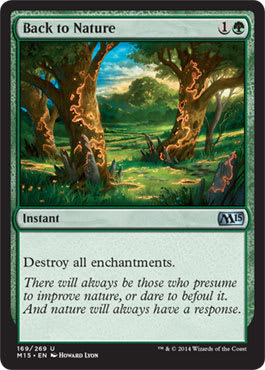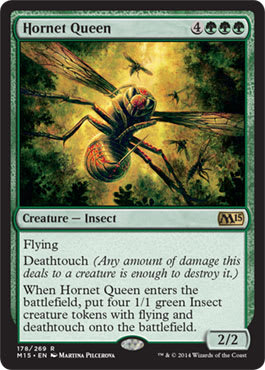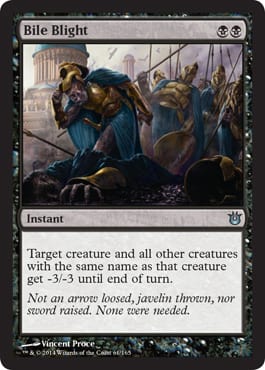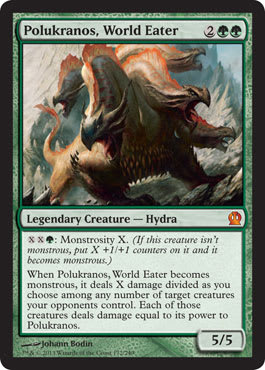There’s a sort of routine I follow whenever a new Magic set is released. Before prerelease weekend even begins, I’m focused on figuring out the new Limited environment. I play in several prerelease events, both in person and on Magic Online, and I spend the next several weeks drafting as much as possible. Now, on the eve of Pro Tour Dragons of Tarkir, I have enough knowledge about the Draft format to provide my own running commentary at home while watching coverage—not to mention stacks of new cards sitting on my desk, waiting to be sleeved up. It’s about time I started playing Standard again.
I focus on Limited at the start of my season for several reasons. For one thing, it’s cost-effective: I win enough prize packs from Limited tournaments that I’m never interested in buying a box and rarely need singles. But I’m also not the type of person who has a dozen deck ideas before the format even becomes legal. I’m not a brewer; I can choose a good deck for an expected metagame and practice with it until it feels like my own, but the decks I built from scratch always seemed to be missing something, and after a while, I just stopped trying. Instead, I take decks that I find online and tweak them to suit my needs, preferences, and metagame predictions. I scour StarCityGames.com, the Mothership, and coverage looking for ideas. In the weeks leading up to the first big Constructed tournaments, I’m at a total loss.
Net-decking has become a common practice in Magic these days, now that the Internet and social media have enabled players to share more information faster. Countless casual players still scoff at their Spikier counterparts, but in wider Magic culture, there’s less of a stigma surrounding the net-decker, as even the best of the best rely on friends and teammates to supply them with tournament-winning lists. Different players have different skill sets, for sure, but it’s also a matter of convenience. When you’re trying to balance Magic with work, school, or other commitments, you can’t spend all your time brewing; sometimes, it’s more advantageous to just choose a solid decklist and sleeve it up. Or perhaps you want to try a completely new format, such as Modern or Legacy, and don’t have the metagame knowledge required to brew up a competitive deck. In all these cases, net-decking is often the safer, easier choice.
Of course, relying too heavily on other people’s deck ideas—and conclusions drawn from reading decklists online—can pose some problems. Today, I want to discuss some of the pitfalls associated with net-decking and show you how you can avoid them.
The Sideboarding Problem
I often try to engage newer players at my local game store in conversations about their progress learning to play Magic, and it seems almost inevitable that we’ll talk about sideboarding. Most players can usually figure out which cards to bring in for certain matchups—especially if their sideboards contain narrow cards like Glare of Heresy or Back to Nature—but can’t identify which main-deck cards are worth ’boarding out. I admit I was an awful sideboarder myself when I was starting out; it wasn’t until I started learning to play Legacy that I understood the benefits of running different configurations of cards on the play and on the draw.
Players who have yet to master sideboarding have an especially hard time sideboarding with decks they find online. “When do I need an extra Murderous Cut?” they ask themselves. “What are all these Planeswalkers for?” Sideboards with a lot of one-ofs are especially impenetrable . . . and sometimes unreliable—at the beginning of a new format, the deck-builder is probably trying to cover as many bases as possible in an unsettled, open metagame.
Every card in every decklist serves a purpose, and it’s important that you understand why the deck-builder chose to include those particular cards—even the sideboard cards! If a deck-builder’s choices don’t make sense to you, customize the deck by making some substitutions or adjusting the numbers. I frequently build my own sideboards, and in dynamic Standard metagames, I rarely play the same seventy-five cards in two consecutive tournaments. No matter what your deck-tweaking methods are, make sure your decisions are grounded in experience; test your deck extensively against a variety of others to ensure that your conclusions are accurate. (For more play-testing tips, consult this article I wrote on the subject.)
The Hornet Queen Problem
As I mentioned when I wrote about intuitive play back in February, I spend a lot of time reading decklists, even decklists that I have no interest in sleeving up. Two years ago, I wasn’t comfortable with the Standard and Modern metagames and had difficulty anticipating how my opponents would ’board against me, so I resolved to play a wider variety of decks and to study decklists more closely. As a result, I knew to play around Hero's Downfall in the Stormbreath Dragon example in my article, even though I also knew that my opponent had about a five-percent chance of drawing one. I firmly believe that reading more articles and familiarizing myself with tier-one decklists has benefited me in the long run . . . but, occasionally, I become too narrow-minded and don’t consider what kind of unusual tech my opponent might have, especially at the Friday Night Magic or Preliminary Pro Tour Qualifier level.
Back in late December, I played what appeared to be a straightforward Abzan Aggro–versus–Abzan Midrange matchup at a small, local tournament. I was the aggro player, and I got off to a fast start, taking Game 1 easily when my opponent missed his land drops. Abzan Midrange wasn’t a great matchup for me, as it had a much better long game, so I turned to my sideboard for more Planeswalkers and late-game options. Most of my sideboard consisted of specific hate cards—Drown in Sorrow for opposing aggro decks, Back to Nature for Whip decks and B/G Constellation—so the best I could do was ’board out my dead cards. Bile Blight seemed less than ideal here; my opponent’s creature base was probably made up of copies of Sylvan Caryatid, Courser of Kruphix, Siege Rhino, and Wingmate Roc. I ’boarded out all four, certain that my Hero's Downfalls and Abzan Charms would get the job done.
The plan seemed to be working in Game 2. One by one, my opponent’s Rhinos met their Downfall, and the Planeswalkers followed suit. Once I had the board presence, I needed to deal lethal damage on the following turn, and I confidently passed the turn. My opponent untapped, played a seventh land, and cast a Hornet Queen.
I was aghast. I had only seen Hornet Queens in B/G Constellation, Sidisi Whip, and Abzan Whip decks—decks that could use Whip of Erebos to abuse its enters-the-battlefield trigger—and my opponent was definitely on regular ol’ Abzan Midrange; I saw a lot of Planeswalkers, no Whips, not even a Satyr Wayfinder. Surely I hadn’t overlooked something? I asked myself. After I lost Game 3, I pulled up StarCityGames.com on my phone and glanced over every Abzan Midrange deck that had recently Top 8’d an Open. I checked and double-checked, thinking I’d lost my mind. There wasn’t a single copy of Hornet Queen to be found.
One of two things had to be true, I thought to myself: Either my opponent had next-leveled the field by running Hornet Queen after discovering that all his Abzan Aggro opponents ’boarded out their Bile Blights against him or he was just playing with the cards he had and subbed in two Hornet Queens for some card he was missing. Perhaps he wasn’t a net-decker at all, and it was my mistake to assume that he was. In retrospect, the decision to ’board out my Bile Blights was probably a good one, as my opponent’s deck still provided few targets—it was the logic behind the decision that needed fixing. I didn’t give my opponent enough credit for original thought, and playing Magic with blinders on ended up costing me a match. I still advocate extensive metagame research, but I’ll add that not every decklist should be treated as a sacred document. Every so often, your opponent may even have a wacky transformational sideboard*; you can’t foresee these kinds of things. Sometimes, you’ll see a card you don’t expect on the other side of the battlefield. That’s just part of the game.
Conclusion
The subject of net-decking has been in the back of my mind ever since I wrote that article about intuitive play, and I’m glad that I’ve finally found the time to explore it. Stock lists are incredibly useful—they’ve helped me prepare for countless Standard tournaments, and I’ve ever piloted a few to victory—but the important thing is not to let them constrain you. Don’t feel obligated to play an exact seventy-five-card list just because it won a major tournament, and don’t rule out the possibility that your opponent is playing a unique seventy-five-card list of her own. As you watch Pro Tour Dragons of Tarkir this weekend, if you find yourself marveling at a decklist you see on coverage, find a way to make it your own.
*A few months ago, I played against a R/G Aggro deck in a PPTQ that had an unconventional sideboard plan. Against other aggro decks, my opponent ’boarded out four Goblin Rabblemasters, four Heir of the Wilds, and three Collateral Damage, ’boarding in four Courser of Kruphix, four Polukranos, World Eater, and three Anger of the Gods. I had never seen anything like it and was completely thrown off during Game 2.





























